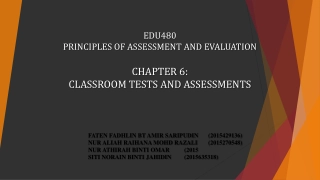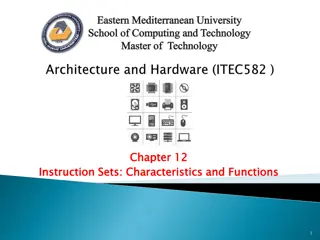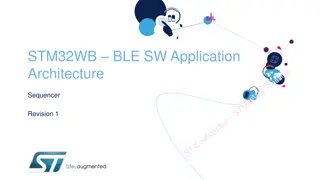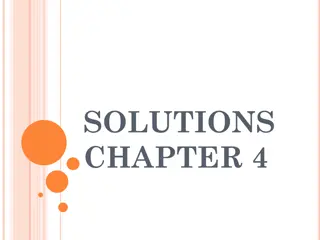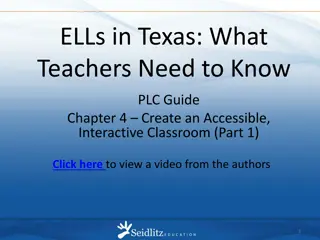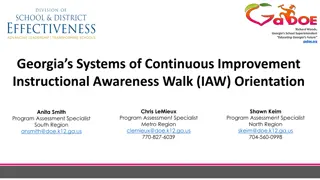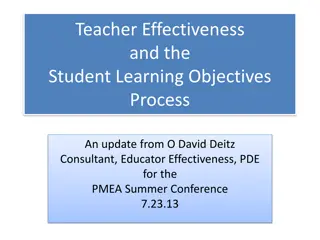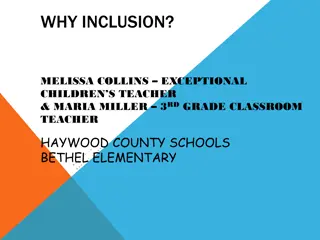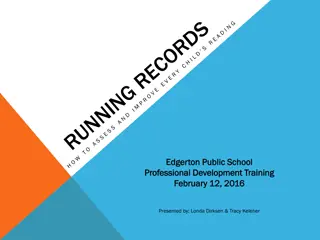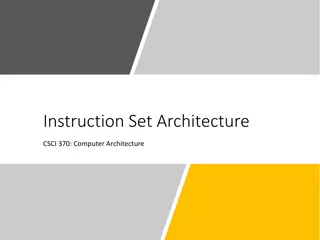Understanding Task Difficulty in Classroom Instruction
This module is designed to educate staff, students, and families on the topic of Task Difficulty within a SW-PBS Classroom setting. It includes slides, notes, and handouts to facilitate learning and discussion. Participants will learn to identify strategies for adjusting task difficulty in various classroom scenarios. The session aims to enhance educators' ability to plan and implement activities that cater to different student needs effectively.
Download Presentation

Please find below an Image/Link to download the presentation.
The content on the website is provided AS IS for your information and personal use only. It may not be sold, licensed, or shared on other websites without obtaining consent from the author. Download presentation by click this link. If you encounter any issues during the download, it is possible that the publisher has removed the file from their server.
E N D
Presentation Transcript
MO SW-PBS Classroom Module Instructions This module is designed to provide the slides and materials needed to teach staff, students and families about a SW-PBS Classroom topic. Notes have been written to assist with the presentation. Handouts needed are shown by a star on the slide. If you have not done so, it is recommended you share module Overview of Effective Classroom Practices before presenting this module on Task Difficulty. Delete this slide before beginning your session.
MO SW-PBS Classroom Module Instructions (continued) More information is available in the Classroom chapter of the May 2014 MO SW-PBS Team Workbook (available on the MO SW-PBS website) about the topic. Follow-up activity suggestions are on the last slide. These are ideas your school/team might review prior to this presentation to present how you plan to expand the learning past this inservice session. Call your Regional Consultant if you have questions. Good luck! Delete this slide before beginning your session.
Handouts These are the handouts needed for this Classroom Module: Task Difficulty Teacher Tool Task Difficulty Personal Reflections Task Difficulty Example Vignettes Addressing Task Difficulty in Your Classroom
Task Difficulty Task Difficulty Teacher Tool 350
Effective Classroom Practices 1. Classroom Expectations 2. Classroom Procedures & Routines 3. Encouraging Expected Behavior 4. Discouraging Inappropriate Behavior 5. Active Supervision 6. Opportunities to Respond 7. Activity Sequencing & Choice 8. Task Difficulty
Outcomes At the end of the session, you will be able to Identify strategies to adjust the task difficulty in common classroom scenarios. Plan strategies to adjust the task difficulty in common activities you ask students to complete in your classroom. MO SW-PBS
Three Levels of Implementation A Continuum of Support for All Academic Systems Behavioral Systems Tier Three Individual Students Assessment-based Intense, durable procedures Tier Three Individual Students Assessment-based High Intensity Tier Two Some students (at-risk) High efficiency Rapid response Tier Two Some students (at-risk) High efficiency Rapid response Tier One All settings, all students Preventive, proactive Tier One All students Preventive, proactive MO SW-PBS 20
Why Consider Task Difficulty? For students, the school day is full of academic demands. When problem behavior occurs primarily in the face of academic demands, it is important to consider what aspect of the task might be contributing to the problem. Many behavior problems are a mismatch between the task and the student s skills. MO SW-PBS 350
Why Consider Task Difficulty? Work assignments that are too difficult for students or require them to use skill sets that are challenging for them, commonly result in problem behavior. Scott, Anderson & Alter, 2012 MO SW-PBS
Is It Fair to Adjust Tasks? Every student should get what he or she needs to be a successful student. For example, if one student were to fall and cut himself, he would be given a bandage. Every student in the class would not get a bandage because not everyone needs one. To be equal, the teacher should give bandages out to everyone, but to be fair, only the student who needs it would be given the bandage. MO SW-PBS
Considering Task Difficulty Consider aspects of the student, the materials, and the task. Three types of adjustments: 1. The length of the assignment of the time allotted. 2. The mode of task completion. 3. The extent of instruction or practice provided. MO SW-PBS
Assignment Length or Time Academics are accurately matched to student s ability, but the length of the assignment exceeds student motivation or endurance. Decreasing overall task length or offering periodic breaks to do something else can decrease problem behavior and aid task completion. (Dunlap, Kern-Dunlap, Clarke & Robbins, 1991) Question to ask: Will the student be able to complete the assignment if time or assignment length adjustments are made? MO SW-PBS
Length or Time Strategies Shorten the assignment, allowing the student to demonstrate mastery with fewer items. Highlight, in color, those problems the student is to complete. Break the assignment up into shorter tasks; put fewer problems on a page. Have shorter work periods with other tasks in between. Have the student cover all items except the one he is working on at the time. Provide physical breaks between difficult tasks. Provide alternative times for the work to be completed. MO SW-PBS
Activity: Personal Reflection Think of a student who you could answer yes to this question: Will the student be able to complete the assignment if time or assignment length adjustments are made? Choose a strategy to try that adjusts assignment length or time to complete. Discuss with a partner. Task Difficulty Personal Reflections
Response Mode The mode that is required to complete a task can contribute to problem behavior. Reading or fine motor deficits, etc. often make reading or writing tasks appear overwhelming. Providing an alternative mode (e.g., computer or tape recorder, paired student reading, etc.) may reduce behavior problems. Question to ask: Could the student do the work if the mode of responding was altered? Does the student have difficulty responding in written format, orally, or when reading is involved? MO SW-PBS
Response Mode StrategiesWriting Provide a choice between written and oral answers. Allow the student to dictate answers to the teacher, an assistant, or peer. Create guided notes to minimize writing. Allow the student to tape record answers to tests or assignments. Allow the student to use other creative modes for demonstrating understanding (e.g., building, drawing, drama, etc.). MO SW-PBS
Response Mode StrategiesReading Include illustrations on worksheets that depict how to complete tasks. Highlight or underline important words in instructions and texts. Create guided notes that limit reading and draw attention to key points. Provide text on recording for the student to listen to as they read. Assign a partner to share the reading requirements and assist the student with unfamiliar words. MO SW-PBS 351
Activity: Personal Reflection Think of a student who you could answer yes to this question: Could the student do the work if the mode of responding was altered? Does the student have difficulty responding in written format, orally, or when reading is involved? Choose a strategy to try that adjusts the mode of responding. Discuss with a partner. Task Difficulty Personal Reflections
Increased Instruction or Practice Using instructional strategies that are appropriate to the student s stage of learning is essential. Some students may not be at the same stage of learning as other students (e.g., acquisition level, fluency building, mastery, or generalization). For some students, they can learn and do the work if there is more teaching, guided practice, or fluency-building activities. Question to ask: Will the student be able to complete the tasks if (s)he has more instruction, guided or individual practice? Task Difficulty Personal Reflection MO SW-PBS
Instruction & Practice Strategies Arrange for additional brief instructional sessions using the modeling-guided practice-independent practice approach (acquisition stage). Arrange for a peer tutor to assist with guided practice opportunities (fluency-building stage). Use partner work to increase fluency with flash cards (fluency-building stage). Use meaningful real life examples for practice and application (mastery or generalization stage). MO SW-PBS
Activity: Personal Reflection Think of a student who you could answer yes to this question: Will the student be able to complete the tasks if (s)he has more instruction, guided or individual practice? How could you provide more instruction, guided or individual practice? Discuss with a partner. Task Difficulty Personal Reflection
Activity: Increased Instruction & Practice Example Vignettes Determine how the teacher might adjust the task difficulty to help the student meet success. Dalton sits quietly, but does not complete his work during writing activities. His reading skills are at grade level. He is able to accurately retell what he has read and can orally answer all comprehension questions. When he is directed to answer comprehension questions on his worksheet, he begins slowly, then stops writing and puts his head down on his desk. Task Difficulty Example Vignettes MO SW-PBS 352
Activity: Increased Instruction & Practice Example Vignettes Find a new partner. Read the remaining vignettes on the handout and determine how the teacher might adjust the task difficulty to help the student meet success. Be prepared to share the strategies you decided. Task Difficulty Example Vignettes MO SW-PBS 350
Activity: Addressing Task Difficulty in Your Classroom Using the handout, list common classroom activities you have students complete in the left column. In the right column, identify some ways you could address task difficulty. Ideas are listed on the back of that handout. If you desire, work with a partner. Be prepared to share. Addressing Task Difficulty in Your Classroom MO SW-PBS
Questions MO SW-PBS
Outcomes At the end of the session, you will be able to Identify strategies to adjust the task difficulty in common classroom scenarios. Plan strategies to adjust the task difficulty in common activities you ask students to complete in your classroom. MO SW-PBS
References Dunlap, G., Kern-Dunlap, L., Clarke, S., & Robbins, G. R. (1991). Functional assessment, curricular revision, and severe behavior problems. Journal of Applied Behavior Analysis, 24, 387-397. Scott, T. M. Anderson, C. M., & Alter, P. (2012). Managing classroom behavior using positive behavior supports. Upper Saddle River, NJ: Pearson Education, Inc. MO SW-PBS
For More Information Missouri Schoolwide Positive Behavior Support websitehttp://pbismissouri.org/educators/eff ective-class-practice
Follow Up Insert expectations your PBIS leadership team and/or administrator have about when each teacher should have incorporated tasks difficulty into lesson plans. Insert how your school will follow up: Will the PBIS leadership team and/or administrator do a walk-through on a specific date or a review of lesson plans? Or will grade level/department teams work together to create lessons that include strategies to address task difficulty? Or will the PBIS leadership team videotape teachers using strategies to address the task difficulty to share with other teachers. Insert how your school will celebrate if the outcomes of the follow up are positive. Delete this slide if your school will not do any follow up activities. MO SW-PBS


